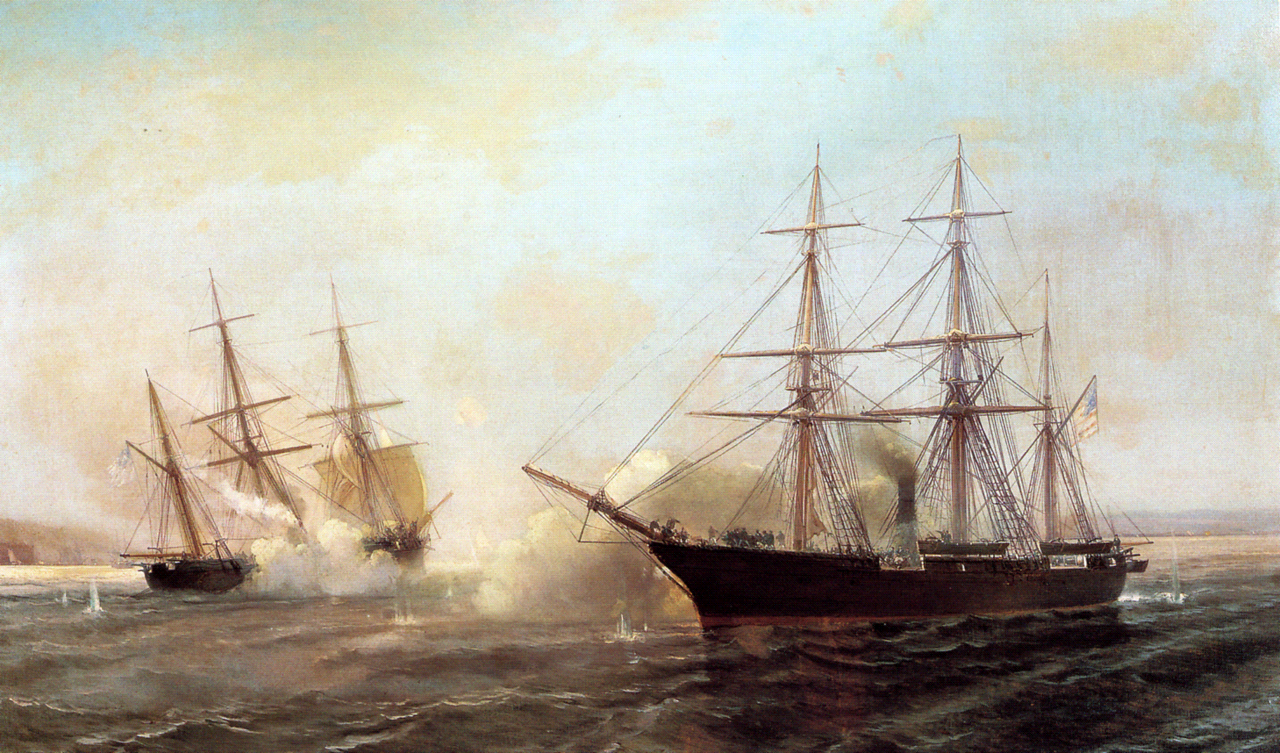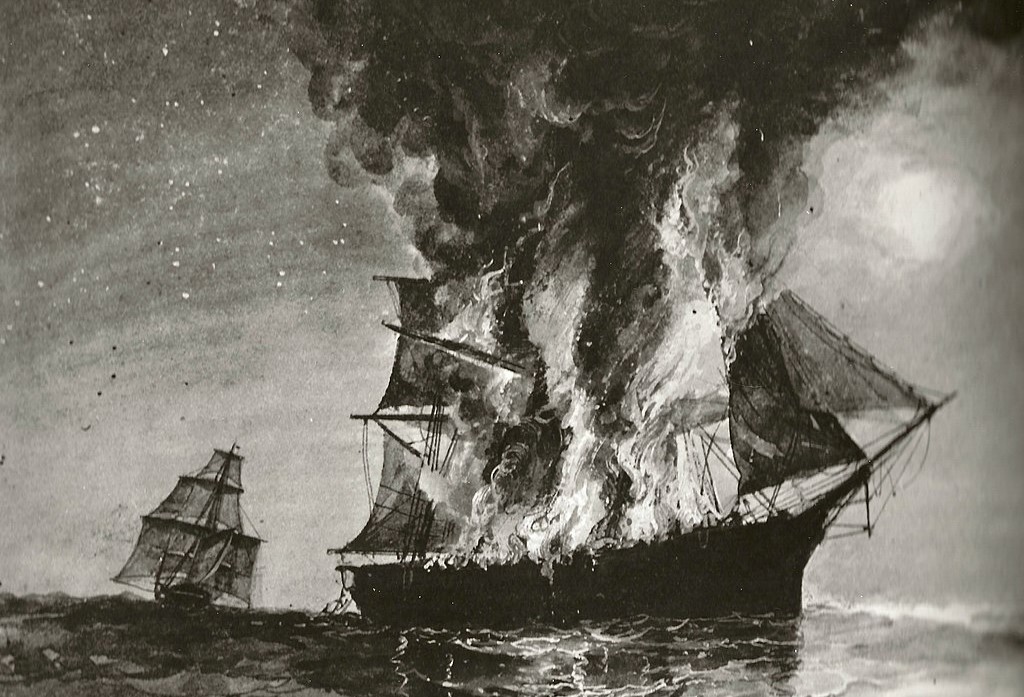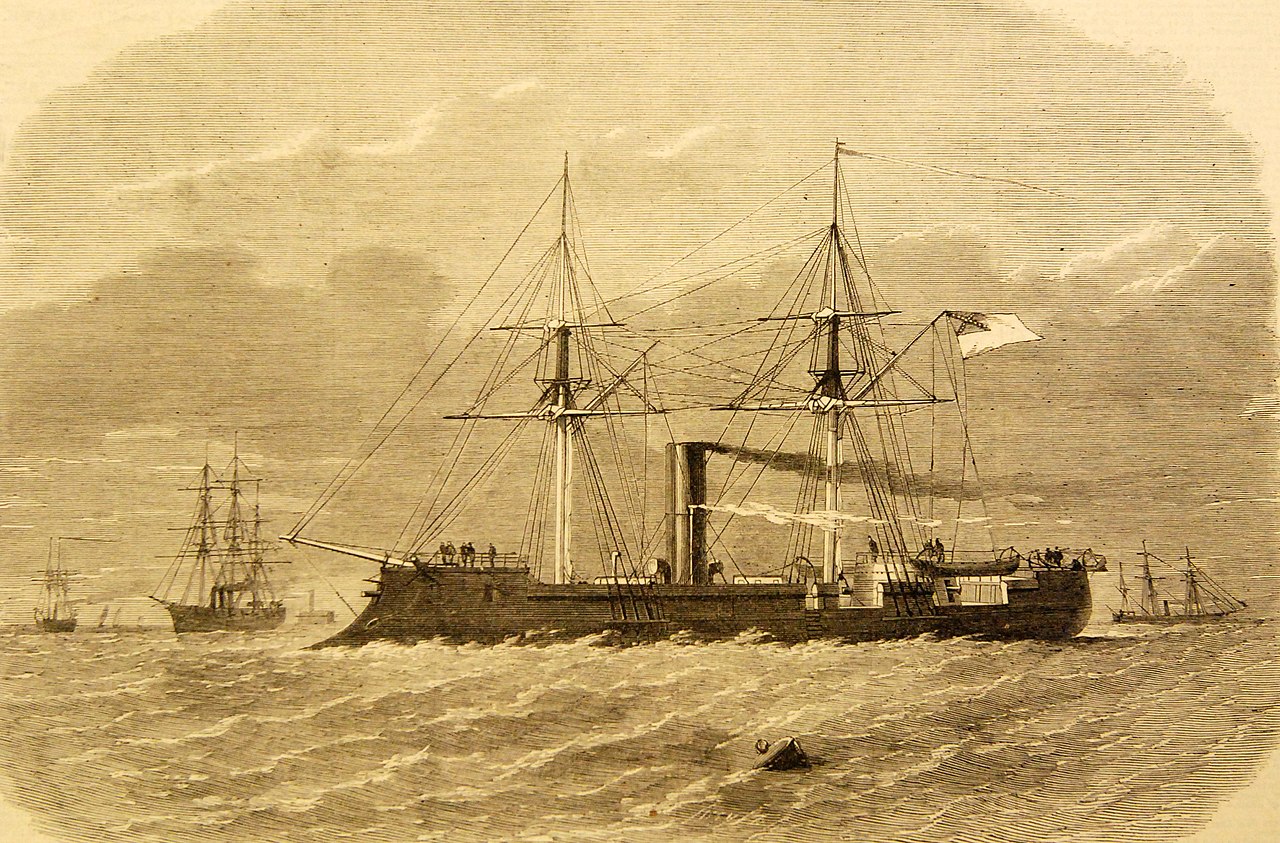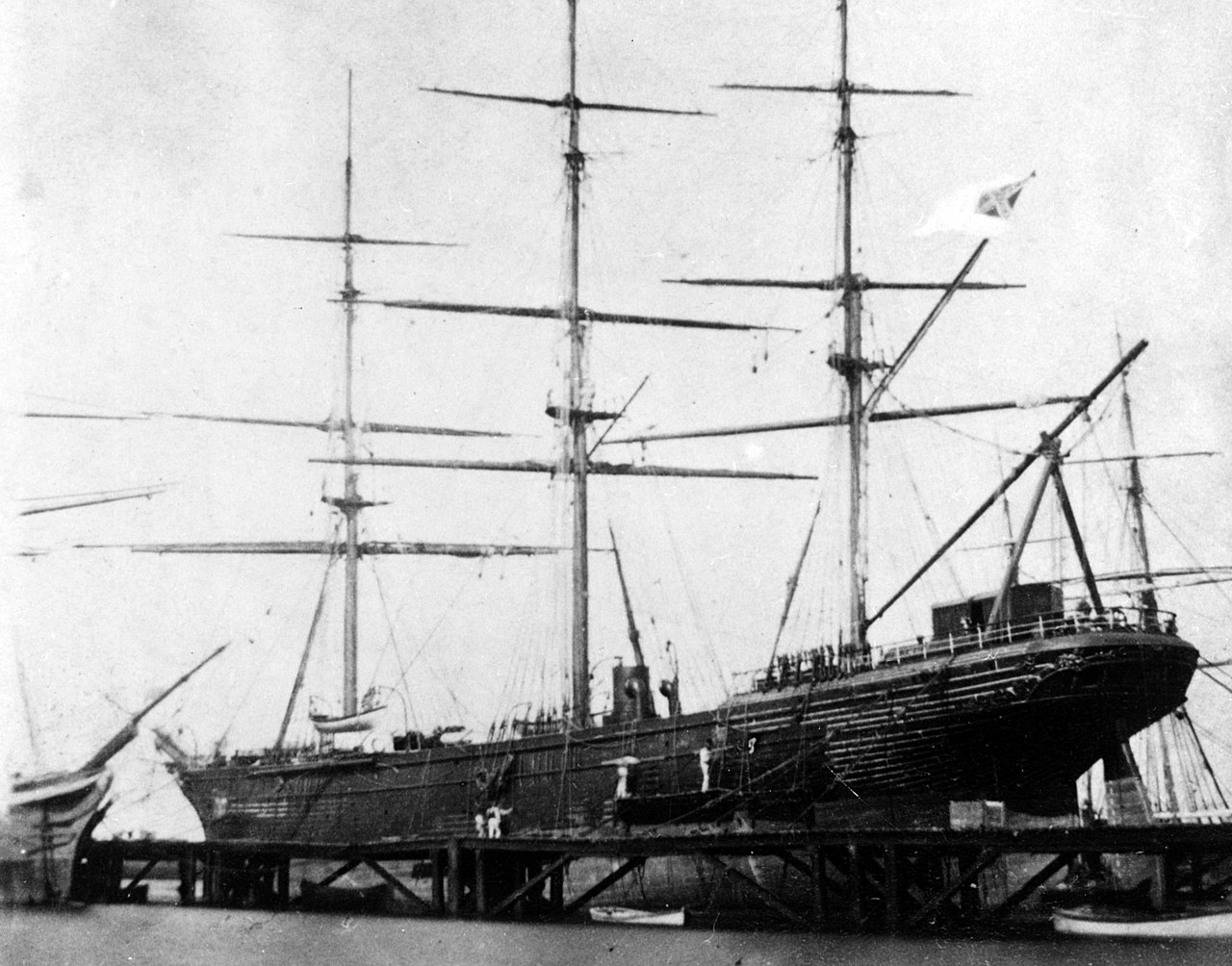When last we left Raphael Semmes, he was taking the famous Alabama to Cherboug, France, for much-needed maintenance. But at Cherbourg, Semmes found the repairs needed by the Alabama delayed—the only dry dock in the port was government run. While Semmes waited for authorization from the French Emperor to use the dry docks, the Union ship Kearsarge, John Winslow commanding, was alerted to her presence and entered the port, whereupon Semmes sent a message to the Kearsarge that he was willing to duel. Semmes could likely have evaded the Kearsarge instead, but his ship was in a poor condition to go to sea, and more Union warships were in en route. Perhaps the poor state of the war at home made Semmes more willing to risk a stand-up fight.

Kearsearge and Alabama clash
Whatever the reason, the ships met by arrangement on July 19, 1864. The two ships were relatively evenly matched—the Alabama had an additional gun, and carried a rifled cannon that gave her an advantage at range. However, the Alabama, normally the speedier of the two vessels, had a fouled hull from her long voyage, likely making her slower than the Kearsarge. The extended period at sea had also decayed her gunpowder. The Kearsarge had better firepower at close range, and, besides the thicker timbers of a warship, she had cables of chain running along her sides that would help absorb cannon shots. Semmes was unaware of this last fact, and afterwards conceded grumblingly that “[t]he days of chivalry being past, perhaps it would be unfair to charge Captain Winslow with deceit in withholding from me the fact that he meant to wear armor in the fight.” The two ships circled each other, the Alabama attempting to keep at range, but her shells—thirteen of which hit the Kearsarge—failed to do significant damage, while the Kearsarge’s fire shredded the Alabama. Semmes attempted to flee back to French waters, but his engine quickly stopped working and water was pouring into the hull of the vessel. The Alabama surrendered (although Semmes escaped on one of the ship’s boats), thus ending the career of the most successful Confederate raider, with 64 prizes and the sinking of the Hallock to its name.
Although the Alabama and the Florida might claim to have nearly swept the seas of American-flagged commerce, Southern agents in Europe had not ceased in their attempts to procure additional raiders and warships for the Confederate cause. Despite Semmes’ best efforts, his distraction had done little to impact the Union blockade, portions of which Mallory wistfully hoped to raise even into 1864.

Tallahassee burns a prize
1864 also marked the late date at which the Tallahassee, a fast, English-built two-propeller craft had seen service as a blockade runner, set sail. She successfully ran the federal blockade and cruised up the Atlantic coast. Despite finding precious few vessels left over from Semmes’ work, she managed to seize and scuttle or burn several craft. But a cool reception and limited coal at Halifax, Nova Scotia forced her to return back home to Wilmington, North Carolina. She successfully re-ran the blockade, and sortied forth one more time as the Olustee, taking a half a dozen more prizes before being reconverted into a blockade runner at the end of 1864.

Stonewall puts to sea
One other remarkable event marked the end of 1864: the first successful acquisition of a European ironclad by the Confederacy. Despite Napoleon III’s strict injunction not to sell any vessels to the South, the shipbuilder for Bulloch’s ironclad rams was unable to find a purchaser for one of the vessels, and in January of 1865 Confederacy was able to take possession of the vessel on its route from Denmark (the original prospective buyer) to France. The ironclad ram, appropriately called Stonewall in Confederate service, was formidable enough that even the U.S.S. Niagara, the North’s largest warship, was unwilling to do battle with her. The commander of the Niagara, ironically named Thomas Craven, was afterwards court-martialed for failing to engage the ship when he had the chance, although as it turned out his unwillingness to do battle cost the Union little, for rough seas prevented the Stonewall (which had poor sea performance) from seeing action before the end of the war.1

Shenandoah in Melbourne
Unlike the Stonewall, which achieved nothing of note besides intimidating the Niagara, the Shenandoah had been quite active. After refitting in Melbourne (over the objections of the local American consul), the Shenandoah burned four whalers in the Caroline Islands and another in the Sea of Okhotsk, before capturing a supply vessel with recent newspapers from California confirming Lee’s surrender—but not confirming that the war entirely over. The captain of the Shenandoah, James Waddell, decided that valor was superior to discretion and continued raiding, burning twenty more whalers before encountering a ship with decisive proof that Southern forces had disbanded in their entirety. Waddell then stowed his guns and sailed to England, surrendering to the Royal Navy there, having captured 30 whalers and eight other ships in his career.
Despite the damage inflicted by the Alabama, the Shenandoah and the Florida, at the end of the day they proved unable to lift the blockade or turn the tide of war for the Confederacy. In our next and final installment, we’ll examine in greater detail and with the benefit of hindsight the effectiveness of the Southern strategy, and whatever flaws it may have had.
1 bean: Stonewall was eventually turned over to the US, who in turn sold her to Japan, where she became their first ironclad, Kotetsu. ⇑

Comments
Always amazing to me how countries used to sell their state-of-the-art warships around so freely. So France sold Stonewall to Denmark, which sold it to the CSA, which surrendered it to the US, which sold it to Japan? Didn't any of these governments think "maybe we shouldn't sell this warship to a rival nation that we don't have an alliance with?"
It was a somewhat more innocent time in terms of international arms sales. Great powers presumably restricted exports of the best new-built warships, but selling off older or second-tier ships from the navy's inventory, or even a private shipyard building warships under contract for a neutral foreign country was a routine matter.
I imagine part of this was a holdover from the then-recent past when there was little in the way of secret military technology and the limiting factors for a military buildup were manufacturing capacity and finances. During peacetime when there was slack in manufacturing capacity, there was little downside to exporting arms and ships since British, French, American, etc muskets, cannons, or frigates were pretty much fungible against one another. And two big advantages from exporting: money comes into the country (improving the economy, which increases the tax base as well as making voters happy) and the export trade helps support a larger active manufacturing base that can be mobilized in wartime. Likewise for obsolete or surplus arms and warships, selling them to other countries raises more revenue that scrapping them would. Especially for wooden-hulled ships that are harder to melt down as scrap.
The main reasons arms exports might be restricted were if you needed your own country's orders to take priority over exports, if war were active or imminent against the prospective buyer, or if (as in the case of the Laird Rams) a friendly country was at war with the buyer and used diplomatic pressure to induce you to block the sale.
Another factor was that the 1860s were still in the era where you could build a useful warship by mounting cannons on a suitably fast and sturdy civilian vessel. Even a purpose-built warship could often be procured through a vaguely plausible fiction that the ship itself was a civilian build while you bought the cannons separately and installed them yourself after taking delivery of the ship. This doesn't really work (or at least the plausible deniability gets very strained) for ironclads or for wooden ships intended for the line of battle, but the difference between a commerce raider and a fast merchant steamship with after-market guns bolted on the deck could be relatively subtle.
British shipyards were still in the business of building major warships for export as late as 1914, when upon the outbreak of war, the government commandeered two Dreadnoughts that were under construction in Britain under contract from the Ottoman Empire.
The modern arms trade still involves some risk of ships or other weapons you sold being used against you, but I also get the impression that earlier times were less careful about keeping military technology secret. (Both in who they sold it to, and in how much they were willing to say about it in public.) I don't know why.
It should be noted that, Denmark didn't buy the ship, because the war she was buying it for was lost by the time the it was built.
... causing the Sultan to get REALLY annoyed, and the Ottoman Empire joining the Central Empires in the Great War.
Great thinking, Sir Winston, indeed...
It's a bit more complicated than that. British-Ottoman relations were pretty bad even before the seizure of the ships. There was apparently a serious plan to sail the ships to Wilhelmshaven and turn them over to the Germans.
bean:
Why would they do such a thing?
Because the Ottoman Empire's greatest enemy was Russia, and the Ottomans had spent a while cozying up with the Germans even before the war. Relations with Britain were reasonably friendly (see the bit about buying battleships from them) but not so much that they could count on the Ottomans not entering the war.
Also keep in mind that in 1914 the Turkish army army and navy had terrible reputations, being kick around in several wars with the small powers in the last 4 years.
We get +2 (or 4) battleships, but we will have to fight the Turks probibly sounds like a good deal.
Was Craven ultimately vindicated in his court martial? I am trying to figure out how Niagara would have squared against Stonewall--the wikipedia article describing it says that Stonewall was "much more powerful". Comparing tonnage reveals Niagara was almost 4 times as large, and seems to have had 12 11 inch guns, compared to Stonewall only having a single 10 inch gun (albeit a rifled one).
@James: No idea about the result of Craven's court martial. But he was later promoted to rear admiral, so I would guess he was acquitted.
The question of Niagara vs Stonewall is interesting too. I think a lot depends on the powder charges in Niagara's guns. In 1862 after the Battle of Hampden Roads, Dahlgren started testing the 11" smoothbore against armor. He found that the standard 15lb charges were ineffective against 4.5" of iron but that if a 30lb charge was used, the solid shot would reliably penetrate 4.5" of iron and 20" of wood backing, at a range of 30 yards and armor inclination of 15 degrees. Different sources give the thickness of Stonewall's armor as between 4.5" and 5.5" so if Niagara was using 30lb charges, then she could probably have done significant damage to Stonewall, assuming that the quality of the armor was comparable to what Dahlgren tested against. If Niagara was using 15lb charges (and I don't know if Dahlgren's test results had been circulated widely) then Niagara would probably not have been able to seriously damage Stonewall.
Niagara also had USS Sacramento along, which was armed with 2 11" smoothbores and a 150lb rifle, so Stonewall would have had to deal with two opponents, both of which were faster and probably more maneuverable than her, and both of which had the potential to damage the Confederate ship at close range. It actually seems similar to the Battle of the River Plate in that regard.
My tentative guess is that Niagara and Sacramento could have defeated Stonewall if they used 30lb charges, but that both ships would have been severely damaged in the process, possibly to the point where they weren't worth repairing.
Some questions I have that seem relevant here are: 1. What was Stonewall's crew like? Could they have handled the ship efficiently in battle? 2. What was the effective rate of fire of Stonewall's 300lb rifle, what was its accurate range, and did it fire explosive shells? In other words, how badly could Stonewall damage Niagara and Sacramento before they closed the range? 3. What about ramming? Could Stonewall have pulled that off without becoming entangled in the ship it rammed and/or boarded by its crew?
Grant:
With Northern industrial superiority even 2:1 loss ratios means it'd still hurt the south much more than the north.
Amusingly, Kotetsu (ex-Stonewall) later fought in another civil war, the Japanese one. Arguably, she was essential for the final defeat of the former Bakufu supporters' Republic of Ezo on Hokkaido. A scenario where the Americans would hand her over to the shogunate instead of waiting might make an interesting alt-history track.